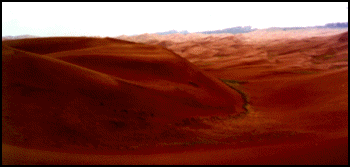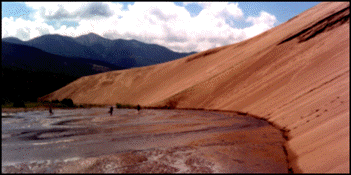December 1, 1995
In southern Colorado, along the jagged edge of the Sangre de Cristo Mountains, sits a huge pile of sand that would completely cover, to the tops of its tallest buildings, the whole of downtown Denver. Seven-hundred-feet tall and covering over 54 square miles, the Great Sand Dunes of Colorado are one of the truly bizarre sights of the American West.
 The land of the Great Dunes is one of divergent landscapes. The terrain on the approach to the dunes is cattle range, green with sage and yellow-flowered rabbit bush, the surrounding foothills verdant with pinon pine and ponderosa. The craggy peaks of the Sangre de Cristo Mountains are silver and gray. Here against all this lush foliage and alpine splendor sits a huge, slowly undulating, seemingly out-of-place sandbox for playful aliens – a gigantic, mind-bending mount of yellow sand, like the crumbled remains of an ancient Egyptian engineering project gone awry.
The land of the Great Dunes is one of divergent landscapes. The terrain on the approach to the dunes is cattle range, green with sage and yellow-flowered rabbit bush, the surrounding foothills verdant with pinon pine and ponderosa. The craggy peaks of the Sangre de Cristo Mountains are silver and gray. Here against all this lush foliage and alpine splendor sits a huge, slowly undulating, seemingly out-of-place sandbox for playful aliens – a gigantic, mind-bending mount of yellow sand, like the crumbled remains of an ancient Egyptian engineering project gone awry.
The dunes were formed over tens of thousands of years as prevailing winds carried sand to the base of the range. The winds could not have possibly carried the sand over the mountains, the nearest being Mt. Humboldt, a majestic 14,000 footer (for more on 14ers, check out Colorado’s 14ers: Never lonely at the top ). The dunes are a big pile of sand where one would hardly expect it, a fantasy landscape of soft and sinewy dunes where light plays delicate tricks on perception and the ever-blowing wind continually sculpts anew.
During our visit, we followed the Abuela Creek along the eastern edge for a few miles, wading through the cool and clean, shallow water, along the base of steep sand cliffs hundreds of feet tall. How does the sand stay put? The hydrology of the dunes provides the answer. Because the water table is so high, the dunes wick water from the creeks, which are fed by abundant snowmelt. Amazingly, the sand is wet and dense a couple of inches under the surface anywhere one scratches.
This cosmic sandbox is a photographer’s paradise. The serpentine dunes, spines and wisps, and soft-lit mounds of fine-grained, medium- to light-yellow sand are perfect for a black-and-white zone photography workout. Climbing to 700 feet, a short hike from one of the Forest Service trail heads, provides an incredible view of the rolling dunes against the craggy, snow-covered peaks of Sangre de Cristos and the flat cattle prairie of the San Luis Valley.
Camping is permitted beyond an imaginary 2-mile boundary into the dunes away from the main trailhead. Remember to pack plenty of water and other bivouac essentials as trekking through sand can be taxing. But the rewards are incredible. The night we camped, in a soft bowl below the wind, the sky was velvet black and we could see to the very ends of the universe. The stars were so bright I had difficulty picking out easy constellations. The Andromeda Galaxy seemed closer than its 2 million light years and the Orionid meteor shower sent golden splinters here and there for as long as we could stay awake.
 This is the ideal place for consciousness-raising. The darkness and stark topography provide the perfect setting to contemplate the universe’s mysteries, far from the ordered, civilized world, under God’s big magnifying glass, the sheltering sky.
This is the ideal place for consciousness-raising. The darkness and stark topography provide the perfect setting to contemplate the universe’s mysteries, far from the ordered, civilized world, under God’s big magnifying glass, the sheltering sky.
Other activities include 4×4 tours for hire at the gas station at the main entrance, a passel of nearby trails including long 14er treks, horseback riding, a nearby resort and golf course (very homey and tastefully hidden among a grove of ancient cottonwoods. If it was tacky I would have dissed it already). Adding to the contrasting nature of the dunes is the fact snowboarders and skiers often show up to ride the dunes. They spray furniture polish or WD40 on their boards and away they go.
The dunes are truly a mystical place. I go at least once a summer from my home in Denver, about three hours away. The nearest town with accommodations is Alamosa about 40 miles west. To enhance the weirdness even more, check out the alligator farm nearby on Colo. 17 near the town of Mosca. The American West is perhaps nowhere quite as alluring as in this slice of Colorado.
Story and photos by Joseph Falco